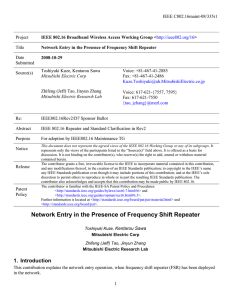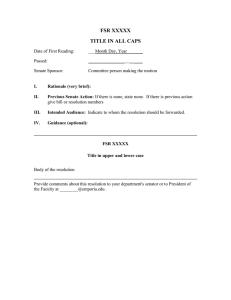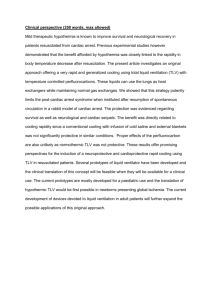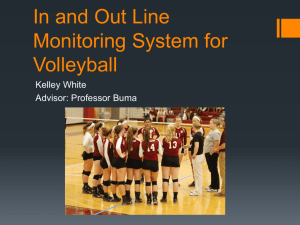IEEE C802.16maint-08/335 Project Title
advertisement
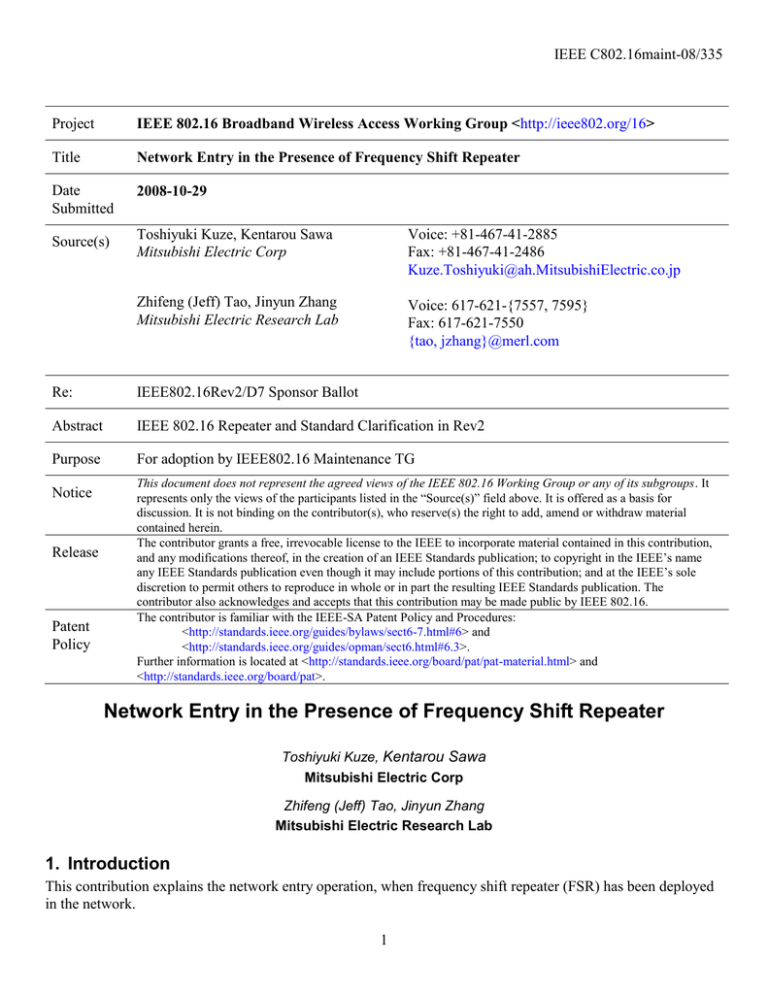
IEEE C802.16maint-08/335
Project
IEEE 802.16 Broadband Wireless Access Working Group <http://ieee802.org/16>
Title
Network Entry in the Presence of Frequency Shift Repeater
Date
Submitted
2008-10-29
Source(s)
Toshiyuki Kuze, Kentarou Sawa
Mitsubishi Electric Corp
Voice: +81-467-41-2885
Fax: +81-467-41-2486
Kuze.Toshiyuki@ah.MitsubishiElectric.co.jp
Zhifeng (Jeff) Tao, Jinyun Zhang
Mitsubishi Electric Research Lab
Voice: 617-621-{7557, 7595}
Fax: 617-621-7550
{tao, jzhang}@merl.com
Re:
IEEE802.16Rev2/D7 Sponsor Ballot
Abstract
IEEE 802.16 Repeater and Standard Clarification in Rev2
Purpose
For adoption by IEEE802.16 Maintenance TG
Notice
Release
Patent
Policy
This document does not represent the agreed views of the IEEE 802.16 Working Group or any of its subgroups. It
represents only the views of the participants listed in the “Source(s)” field above. It is offered as a basis for
discussion. It is not binding on the contributor(s), who reserve(s) the right to add, amend or withdraw material
contained herein.
The contributor grants a free, irrevocable license to the IEEE to incorporate material contained in this contribution,
and any modifications thereof, in the creation of an IEEE Standards publication; to copyright in the IEEE’s name
any IEEE Standards publication even though it may include portions of this contribution; and at the IEEE’s sole
discretion to permit others to reproduce in whole or in part the resulting IEEE Standards publication. The
contributor also acknowledges and accepts that this contribution may be made public by IEEE 802.16.
The contributor is familiar with the IEEE-SA Patent Policy and Procedures:
<http://standards.ieee.org/guides/bylaws/sect6-7.html#6> and
<http://standards.ieee.org/guides/opman/sect6.html#6.3>.
Further information is located at <http://standards.ieee.org/board/pat/pat-material.html> and
<http://standards.ieee.org/board/pat>.
Network Entry in the Presence of Frequency Shift Repeater
Toshiyuki Kuze, Kentarou Sawa
Mitsubishi Electric Corp
Zhifeng (Jeff) Tao, Jinyun Zhang
Mitsubishi Electric Research Lab
1. Introduction
This contribution explains the network entry operation, when frequency shift repeater (FSR) has been deployed
in the network.
1
IEEE C802.16maint-08/335
In contribution C802.16maint-08/295r2 [1], we propose to introduce a new TLV called FSR frequency TLV.
This TLV is broadcast by the BS in DCD/UCD message to indicate the frequency band used by the FSR to
communicate with mobiles. For the sake of simplicity, we will categorize a device (i.e., MS or BS) as Rev2
device or legacy device, depending on whether or not it can support this new FSR frequency TLV. For
example, those MSs that can understand FSR frequency TLV will be referred to as Rev2 MSs.
For simple FSRs, both the outdoor and indoor frequency should be specified in advance by operator. Therefore,
the mapping relation between outside and inside frequency would be fixed. In this contribution, only simple
FSRs following this fixed mapping approach will be considered.
2. Network Entry
2.1 Rev2 MS and Rev2 BS
Network entry in outdoor environment
As illustrated in Figure 1, when MS attempts to enter network in outdoor environment, it will connect to
outdoor frequency (e.g., F2). MS decodes the DCD/UCD and gets the center frequency TLV. Since the
frequency (e.g., F2) which MS synchronizes with is equal to the one contained in center frequency TLV, MS
shall conclude that it is communicating with BS directly.
F2
F2
F1
BS
FSR
DCD(Freq.TLV=F2,
FSR.Freq.TLV=F1)@F2
MS
Figure 1: Network Entry (outdoor)
Network entry via FSR
As shown in Figure 2, when MS attempts to enter network in indoor environment during idle mode, it will
end up synchronizing with indoor frequency (e.g., F1) after wake-up. MS will decode DCD/UCD and get
the center frequency TLV and FSR frequency TLV. The MS compares the value of the synchronization
frequency with center frequency TLV, and finds that they are different. Then MS compares the value of the
synchronization frequency with the FSR frequency TLV, and finds that these values are matched. Thus MS
concludes that it is communicating with BS through an FSR.
DCD(Freq.TLV=F2,
FSR.Freq.TLV=F1)@F2
F2
DCD(Freq.TLV=F2,
FSR.Freq.TLV=F1)@F1
F2
BS
F1
FSR
MS
2
IEEE C802.16maint-08/335
Figure 2: Network Entry (indoor)
3. Proposed Text
[Insert the following new subclause]
6.3.27 FSR support
Frequency shift repeaters (FSR) use one frequency to communicate with BS, and use a different frequency to
talk to MSs. As shown in FigureX, for example, repeaters convert the frequency F2 to frequency F1 for
downlink, and vice versa for uplink communications.
DCD(Freq.TLV=F2,
FSR.Freq.TLV=F1)@F2
F2
DCD(Freq.TLV=F2,
FSR.Freq.TLV=F1)@F1
F2
BS
F1
FSR
MS
Figure X: Frequency shift repeater
For simple FSRs, both the outdoor and indoor frequency should be specified in advance by operator. Therefore,
the mapping relation between outside and inside frequency would be fixed.
6.3.27.1 Synchronization
When MS synchronizes with indoor frequency (e.g., F1), MS will decode DCD/UCD and get the center
frequency TLV and FSR frequency TLV. The MS compares the value of the synchronization frequency with
center frequency TLV, and finds that they are different. Then MS compares the value of the synchronization
frequency with the FSR frequency TLV, and finds that these values are matched. Thus MS concludes that it is
communicating with BS through an FSR.
4. Reference
[1] Toshiyuki Kuze et al., “IEEE 802.16 Repeater and Standard Clarification in Rev2”, IEEE C802.16maint08/295r2, Kobe, Japan September 2008
3

